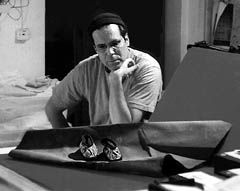
Hidden Things
A film in association with the Memorial Foundation for Jewish Culture and Yad Vashem.
"I choose Gerta from all my dolls, always... I was sleeping with Gerta, eating with Gerta, going to the toilet with Gerta. It was something like a part of my body... a part of me. She reminds me the time when I was happy, she reminds me of my father. She reminds me the day when I was with my father and I chose her." Eva Himovitzch
The filmmakers initiating this project aim to create a powerful visual poem that will illuminate the lives of Jewish children who experienced the Holocaust. Jewish children, many of whom spent precious years of their childhoods within Nazi concentration camps or in hiding, were a special target in the scheme to eradicate the Jewish race, for they were the crucial link to the future. Who were these children? How did they muster the will and ability to survive under such enormous duress?
Rounded up throughout Europe, speaking different languages and coming from varied traditions and cultures, these children shared a common need to learn, to remain intellectually curious and, most stunningly, to play, like children everywhere. They played, passionately, with anything and everything, whether manufactured or handmade — dolls and board games, balls and books, toy trains and drawing tools. This need to retain childhood in the midst of extremity imposed its own hardships and proved, in some cases, impossible. But for many who did survive, the creative capacity to play and fantasize, the ability to escape mentally from the death camps and hiding places, provided vital sustenance and helped them endure this inhuman experience, allowing them to go on to fruitful, rewarding lives.
During the Nazi reign of terror, 1.5 million Jewish children were murdered. Those children who survived are now elderly, the last living connections to one of the most tragic events of human history, and their lives are now rapidly nearing completion. This moment provides a compelling opportunity for us to reach back into history and touch the experiences they had as children. The filmmakers for Hidden Things are uniquely suited to bring those experiences to the screen, through access to telling artifacts collected from that time and to the stories of child survivors themselves.
The filmmakers will have the co-operation of the curators of Yad Vashem in Jerusalem, a museum with an extraordinary collection of artifacts, many of which have never been seen by the public. Bearing witness to the attempts of victims to escape from the nightmare world in which they were trapped, these artifacts possess what can only be described as a powerful aura — something causing one to instantly feel the presence of those long-ago children. They are saturated with the stories, the inner lives and dreams of their now-absent owners. The film will convey the characteristics of these objects in a way that makes present the ghosts of those children.
There will also be extensive interviews with child survivors of the Holocaust. Now, much later in life, they look back at a stolen childhood and confront painful memories. Some — ashamed, uncertain they'd be believed, or simply unable to bear recounting the horrors — have never before told their stories. Now they are ready to speak. All of them have accomplished wonders. People like Fred Lessing, who as a small Dutch boy in Amsterdam posed in the front row of a group photograph of several hundred children. He was the only survivor.
The fullness of their lives testifies to the strength of the children they once were, as well as to the unique adults they've since become.
An international array of accomplished performing artists will contribute to a wonderfully rich aesthetic experience. Ranging from traditional songs performed by an opera singer and clarinet quartet in a beautiful synagogue in Prague, to a commissioned segment developed by a Czech puppet theater, to exciting new compositions created for this project by several renowned rock musicians,the contemporary performances will blend fluidly with the interviews, archival footage, and close examination of children's garments and toys. Employing diverse visual imagery, language, and music, this film will make palpable the intense emotions and enduring struggle of remarkable people.
In the opinion of this film's producers, though a number of wonderful and important documentaries and other films about the Holocaust have been created in recent years, no other work has been similarly conceived as a visual poem. This film is not intended as a definitive piece on the Holocaust, not intended primarily to convey facts and information or exhaustive research. Instead, its creators intend, through art, to provide an opportunity for new experience, to provoke new questions and a new sense of connection with past children's lives, both tragic and inspired.
With his unique sense of combining documentation and artistry, Elliot Caplan presents an emotionally powerful, beautiful, and lasting work on the children of the Holocaust.





